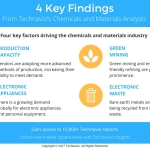Demand From Textiles Industry to Boost the Superhydrophobic Coatings Market: Technavio
LONDON–(BUSINESS WIRE)–#Coatings—Technavio
market research analysts forecast the global
superhydrophobic coatings market to grow at a CAGR of more than 33%
during the forecast period, according to their latest report.
The market study covers the present scenario and growth prospects of the
global superhydrophobic coating market for 2017-2021. The report
also lists fluoropolymers, silica, metal oxides, and carbon
nanomaterials as the four major product segments.
According to Kurva Samba Sivudu, a lead analyst at Technavio for paints,
coatings, and pigments research, “The market for superhydrophobic
coatings is emerging with a wide scope for applications in the
electronics, textile and leather, automotive, building and construction,
and other industries. The market is projected to grow significantly in
the future owing to the increasing demand from the end-user industries.”
This report is available at a USD 1,000 discount for a limited time
only: View
market snapshot before purchasing
Buy 1 Technavio report and get the second for 50% off. Buy 2
Technavio reports and get the third for free.
Technavio analysts highlight the following three market drivers that are
contributing to the growth of the global superhydrophobic coatings
market:
- Growing demand in power electronics
- Increase in adoption in textiles
- Rising demand for energy-efficient solar cells
Looking for more information on this market? Request
a free sample report
Technavio’s sample reports are free of charge and contain multiple
sections of the report including the market size and forecast, drivers,
challenges, trends, and more.
Growing demand in power electronics
The use of electronic goods has been increasing significantly over the
years. These are sensitive to water and moisture, thereby creating the
demand for waterproof coatings (superhydrophobic coatings). Electronics
manufacturing companies are also emphasizing on the development of
waterproof coatings. For instance, Sony launched waterproof Xperia Z1
Android phone in the market in 2013, earning the highest sales in the
market. In recent years, many electronic manufacturing companies have
been launching waterproof electronic gadgets to increase the sales of
electronic products. The electronics industry is expected to post high
growth rate in APAC and the Americas. This will influence the
consumption of superhydrophobic coatings during the forecast period.
Increase in adoption in textiles
Superhydrophobic
coatings have gained significant scientific and industrial interest
owing to their potential applications in outdoor wear and protective
textiles. Superhydrophobic textiles exhibit not only excellent water,
stain, and oil repellence but also possess self-cleaning properties that
reduce the frequency of washing. The reduced need for laundering
maintains the functionality and durability of textiles and reduces the
consumption of resources, detergents, and water.
“Superhydrophobic and self-cleaning properties are being developed
for textiles by lowering the surface energy of the textile fibers using
materials such as carbon nanotubes, titanium dioxide, zinc oxide, and
silica. The superhydrophobic property is attained by the 3D
nanostructures, and self-cleaning titanium dioxide imparts antibacterial
property and acts as a photocatalyst that treats organic compounds,” says
Kurva.
Rising demand for energy-efficient solar cells
Many countries have been working toward the development of clean and
green energy due to the greenhouse effect and lack of availability of
non-renewable power resources such as fossil fuels. Fuel cells, wind
turbines, and solar cells are among the potential technologies that can
aid in harnessing energy from renewable sources.
Among these, the cost of solar power is significantly low, and this
creates the demand for solar cells throughout the globe. As sunlight is
the main resource for solar cells, deposition of dust on the glass of
solar panels can reduce the efficiency of the panel by 10%-20% depending
on the thickness of dust accumulated. Cleaning the solar panels is a
dangerous and costly process. Applying superhydrophobic coatings on
solar panels can easily clean the dust by rain or manually spraying
water. The rise in the demand for solar cells will consequently increase
the consumption of superhydrophobic coatings in the coming years.
Browse Related Reports:
-
Global
Flexographic Printing Inks Market 2017-2021 -
Global
Pipe Coating Market 2017-2021 -
Global
Construction Repaint Market 2017-2021
About Technavio
Technavio
is a leading global technology research and advisory company. Their
research and analysis focuses on emerging market trends and provides
actionable insights to help businesses identify market opportunities and
develop effective strategies to optimize their market positions.
With over 500 specialized analysts, Technavio’s report library consists
of more than 10,000 reports and counting, covering 800 technologies,
spanning across 50 countries. Their client base consists of enterprises
of all sizes, including more than 100 Fortune 500 companies. This
growing client base relies on Technavio’s comprehensive coverage,
extensive research, and actionable market insights to identify
opportunities in existing and potential markets and assess their
competitive positions within changing market scenarios.
If you are interested in more information, please contact our media team
at media@technavio.com.
Contacts
Technavio Research
Jesse Maida
Media & Marketing Executive
US:
+1 630 333 9501
UK: +44 208 123 1770
www.technavio.com
.gif)









